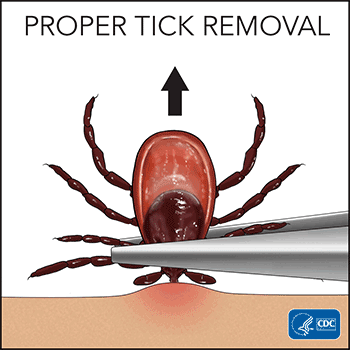Avoid Ticks (and Lyme Disease) This Summer
The best way to prevent Lyme disease is to not get bitten by a tick, or to get it off your body within 24 hours. However, that doesn’t mean you shouldn’t enjoy the great outdoors.
Ticks are most active in the summer and early fall, but these tips can help you stay safe year-round:

Stay toward the middle of hiking trails. On hikes, walk in the center of the trail to avoid leaves, dense brush and tall grass—where ticks are more likely to be lurking. For extra protection, wear long-sleeved shirts, long pants and closed-toed shoes. Tuck your pant legs into your shoes or socks. Spray insect repellent on your clothes and exposed skin. Use proven repellents, containing at least 20% DEET.
Do a body check for ticks after spending time outside. Ticks are often found in hard-to-see places. Search your entire body (you may need to use a mirror) and check your kids, too. Pay special attention to these spots:
- Scalp
- Ears
- Armpits
- Belly button
- Waist
- Between the legs
- Behind the knees
- In and around all body hair
Use a tick collar on pets and check them often. Cats and dogs can bring infected ticks into your home.
What if I get a tick bite?
Remove the tick as soon as you see it. Your chances of getting Lyme disease are reduced if you remove the tick within 24 hours of being bitten.

Using clean, fine-tipped tweezers, pinch the tick as close to your skin as possible. Pull straight up. If you twist or jerk, the mouth parts of the tick can stay embedded in your skin. If that happens, use tweezers to remove mouth parts. Then, wash the area and your hands with rubbing alcohol or soap and water.
Note the date on your calendar and where you think you might have acquired the tick. If you develop a rash or fever, call your healthcare provider as soon as possible.
A red rash, known as erythema migrans, occurs in approximately 70–80% of those infected. It begins at the site of a tick bite after a delay of anywhere from 3–30 days. The average onset is about seven days. The rash gradually expands over a period of a couple of days and can reach up to 12 inches (or more) across. Parts of the rash may clear as it grows, resulting in a “bull’s-eye” appearance; it may feel warm to the touch but is rarely itchy or painful.
Generally, tick bites are not a cause for concern. However, you should reach out to your healthcare provider if you develop a rash, think the bite site is infected or develop flu-like symptoms, including fever, chills, fatigue, muscle and joint pain, or a headache. To learn more about bite prevention, symptoms and removal tips, visit: cdc.gov/ticks








